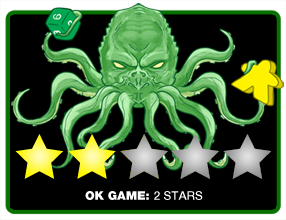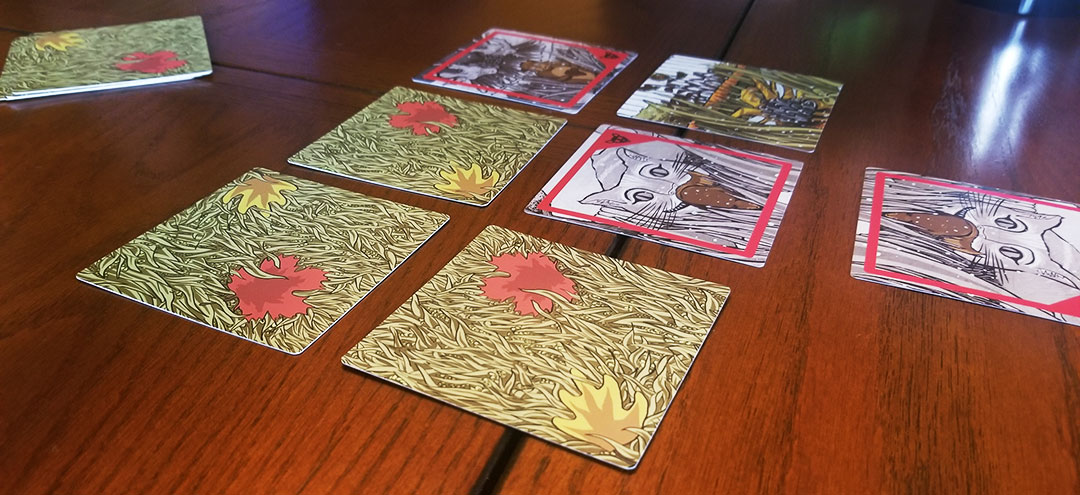 Animals have always been a popular theme in board games, and that trend seems to be rising in the last few years. While not as pronounced as 2019’s darling engine builder Wingspan, what about a game focused on squirrel’s gathering food for the winter. In Squirrel or Die, players are hiding their food in autumn, attempting to remember where they kept it. If their memory serves them wrong, they’re faced with a death from cats (or a bomb). The last squirrel standing is the winner.
Animals have always been a popular theme in board games, and that trend seems to be rising in the last few years. While not as pronounced as 2019’s darling engine builder Wingspan, what about a game focused on squirrel’s gathering food for the winter. In Squirrel or Die, players are hiding their food in autumn, attempting to remember where they kept it. If their memory serves them wrong, they’re faced with a death from cats (or a bomb). The last squirrel standing is the winner.
Gameplay Overview
Squirrel or Die is not a long game but plays in two phases: autumn and winter. In autumn, players are hiding their food in a grid (4×4 in a two-player game, 5×5 for three or four players). A card is first added face-up to the grid. Then, the active player exchanges one of the three cards in their hand with one of the cards in the grid. The catch is that the new card added to the grid from their hand is placed face-down.
This continues until there are no more cards from the deck to place initially in the grid. Once a player can no longer exchange a card, then cards will just be added face-down to fill the grid. Winter then happens, where players flip over a card in the grid. If they flip over a food card, they are safe. If a death card is revealed, they lose one of their three lives. The last squirrel standing is the winner. If all the cards are revealed and two players are still living, it is the squirrel that collected the most food that ends up the winner.

Game Experience:
Squirrel or Die has the huge benefit of lasting 10 minutes. The game scales based on player count by resizing the grid. Each turn plays out the same, as players are working to gather information, they will keep to themselves in two ways. The first is the cards that are flipped into the grid and added to the players’ hands. The other is when a card is added face-down to the grid. Both are near equal in importance. One gets a player better cards to add to the grid. The other is knowledge of which cards are safe and which are deaths.

The problem is that not enough information is given at higher player counts. Memory is a necessity for lasting more than a few rounds in the winter phase. So, in a 4-player game, the amount of information one receives from their cards is a quarter of the information at play in the game. While watching what other players pick up is a valid strategy, it only adds to the fact that memory is the most important aspect of Squirrel or Die.
I’ve yet to mention that there is a small amount of special ability cards in the deck. One is a bomb that causes two deaths when revealed in winter. One is a sleeping squirrel in a birdhouse that snoozes through their next winter turn, and similar to that is a card that makes the drawing player take another card. Another is a love card, giving that squirrel an extra life. There’s also a confused cat card, which allows the drawing player to give an opponent a death.

I’m unsure the balance of these special cards. Some of them you’ll want to exchange and remember their location in the grid so you can grab it. Others, like the death cards, you grab and place in the grid to remember what cards not to pick up during winter. If you go for avoiding the cards, you’re left guessing as to which cards are safe picks.
One of the most powerful cards I’ve seen is the love card. Once a player has one life extra compared to other players, they’re in a much better position. They then become a target of the confused cat card. If the same player that reveals the love card also nabs the confused cat, they are in a prime position to win now that they cannot be purposely targeted.
The art is good, much better than expected from a game of this weight and theme. The back of the cards have a great look when the grid is full, with blades of grass blending well to form an autumn backyard. The food and death cards are easy to differentiate, due to both the color of the cards and having a border and symbol different from each. The storage of the game is also nice, fitting into a small, square deck box.
Final Thoughts:
Squirrel or Die is a quick filler that bases 90% of its mechanics around memory, which doesn’t make for great modern design. It has nice art and a cute theme, but the strategy is lacking in this game. Squirrel or Die’s largest strength is the quick playtime. 10 minutes is quicker than most fillers on the market, even if the decision space is minimal.
Final Score: 2 Stars – Squirrel or Die is inoffensive but doesn’t offer enough depth to stand out among the crowded filler game market.
 Hits:
Hits:
• Cute art and theme
• Quick playtime
• Nice portability
Misses:
• Deeply focused on memory
• Lack of weighty decisions
• Luck of the draw is heavy






















